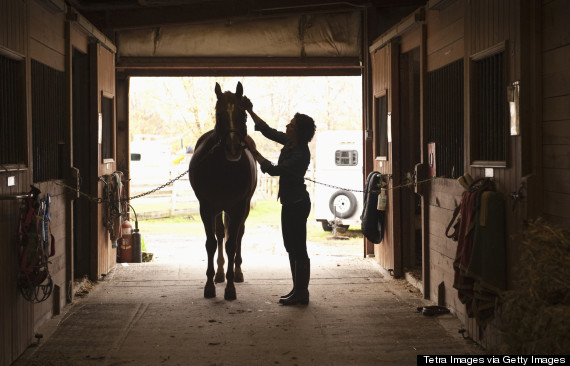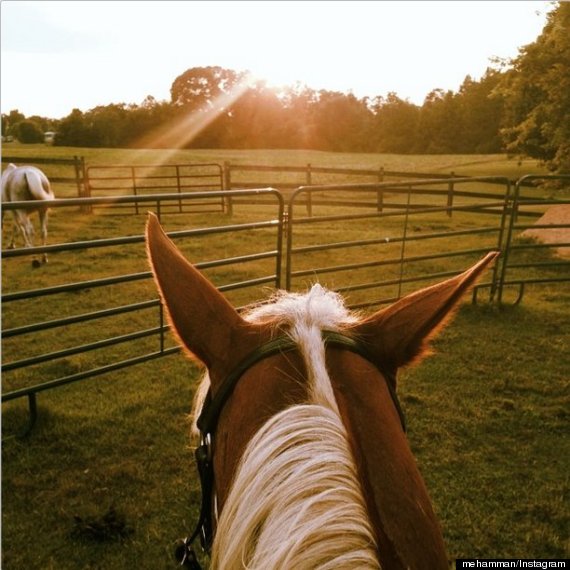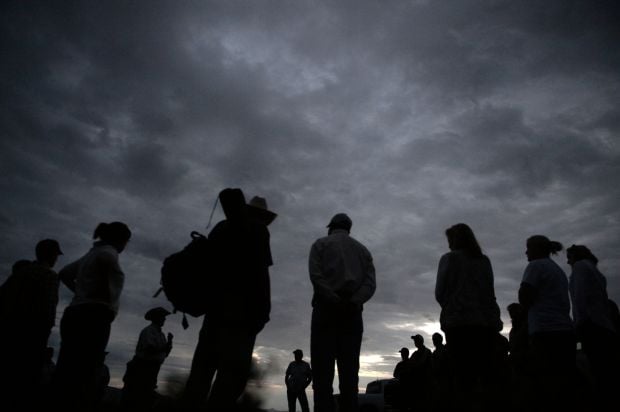Sixty years ago, a barrier was broken for the US military — the first animal ever was promoted to sergeant. But Reckless the horse was no ordinary beast. Serving with valor in Korea, she saved the lives of fellow Marines and was decorated with presidential citations and two Purple Hearts. In this excerpt from the new book, “Sgt. Reckless: America’s War Horse” (Regnery History), writer Robin Hutton tells her story.
In the spring of 1954, as the Korean War was winding down, Navy Corpsman Robert “Doc” Rogers decided to buy a Marine a drink.
“I heard stories about the guys. Marines would come in drunk off of liberty and they’d go down and say, ‘Let’s go down and let Reckless out.’ And they’d do it — just to see what trouble she’d get into.”

Sgt. Reckless: America’s War Horse by Robin Hutton
That Reckless was a horse didn’t really matter. She loved beer — and camaraderie.
“Sometimes the guys would be standing around talking and she’d walk right up to us and just stand there,” Doc Rogers said. “And somebody would be talking and she would look at him. And the other guy would start talking and she’d look at him. And another guy would talk and she’d look at him. It was like, ‘Hey, I’m a Marine. I’m one of you.’
“One night a bunch of us were all standing around in a circle, talking. There was a Marine lieutenant there. Lieutenant Louie was his name. And while we were talking, Reckless came up behind this one soldier and muzzled the back of this guy’s neck. Nipped him on the back of his neck. It scared him half to death and he screamed, ‘What the f—!’ and jumped and turned around. And he’s right face to face with Reckless, and shouted, ‘Get that motherf—–g nag out of here!’
“And Lieutenant Louie exploded on the guy and said, ‘That horse has done more for the United States Marine Corps than you have, or ever will do. And besides that, she outranks you. And if I ever hear you talking to that horse like that again, I’m going to have you written up and court-martialed.’”

Reckless is trained not to be spooked by the noise of rifles. Photo: Command Museum, Marine Corps Recruit Depot, San Diego
‘Reckless ! Let’s call her Reckless!” a voice cried out from the crowd of Marines gathered around their newest recruit. The name might have seemed ill-suited for a small, chestnut-colored horse with a blaze down her forehead and three white stockings.
But to the Recoilless Rifle Platoon of the 5th Marines, the moniker was perfect — it was their radio call sign and captured the toss-caution-to-the-wind attitude of men who relied on the “reckless” rifle.
The little Mongolian mare was born Ah-Chim-Hai, or “Flame-of-the-Morning,” and raised to race at a Seoul thoroughbred track. She officially joined the Marines on Oct. 26, 1952, after the commander of the Recoilless Rifle Platoon, Eric Pedersen, bought her for $250.

Marines lace canisters of ammunition onto RecklessPhoto: Command Museum, Marine Corps Recruit Depot, San Diego
Not as a mascot, but because his unit desperately needed help hauling heavy guns and artillery over Korea’s rugged terrain. Trucks simply couldn’t negotiate the steep, rutted mountains, especially in frigid, icy conditions. Pedersen realized a horse would make the ideal ammunitions carrier.
Because it had no wheels and sat on a tripod, the 75 recoilless rifle, at 6-feet-10 inches long and weighing nearly 115 pounds, was awkward and challenging to carry; moving it in the field usually required three and at times four men, though sometimes two could manage. It could throw a 75 mm shell several thousand yards with extreme precision.
Reckless was put through “hoof camp,” learning how to get on and off a trailer, carry the rifle and ammunition, and not stand behind the gun as it was fired. The horse was even taught to lie down or kneel in case she needed to crawl into a shallow bunker for protection from incoming fire.
After much experimentation, the platoon found Reckless could safely and easily carry six rounds of recoilless rifle ammunition in canisters without much trouble. Yet in the heat of battle, they found she could tote eight to 10 rounds, if necessary.

Reckless on a hill with the gun crew.Photo: USMC History Division, Quantico, VA
The day of Reckless’s long-awaited “baptism by fire” finally arrived in late November 1952. The intended firing line was the colorfully nicknamed “Hedy’s Crotch,” a valley between outposts Ingrid to the south and Hedy to the north (the Marines named the hills after famous actresses), in the center sector of the Jamestown Line.
The Jamestown Line was a series of defensive positions occupied by UN forces stretching about 35 miles from the Imjim River near Munsan-ni, to a point east of Kumhwa, South Korea. The distance from camp to the firing site was 2¹/₂ miles. Part of the way could be traveled by Jeep, but the final five hundred yards was a steep climb to the ridgeline.
Three trucks were sent out at 10-minute intervals. The squad, led by Lt. Pederson and Sgt. Ralph Sherman, and weapon went out first, followed by Reckless in her trailer and finally the ammunition.
When they reached the base of the ridge, Reckless sensed something was up. She clambered out of the trailer, and headed straight to Technical Sgt. Joe Latham’s pocket, sniffing for chocolate.
But her trainer stopped her. “No pogey bait ’til this is over,” he said as he strapped on six canister rounds of high-explosive shells on her and slapped her backside for encouragement. (“Pogey bait” is Marinespeak for non-issued food or drink, especially sweets.)

Reckless loaded with a reel of communication wirePhoto: Nancy Latham Parkin
Pvt. 1st Class Monroe Coleman, a Utah native who was Reckless’ minder, took the horse’s lead rope and started up the steep hill.
The key to a successful mission was speed and teamwork. And now they were about to see how their newest recruit would handle the pressures of battle.
Reckless and Coleman had just returned to the firing line with their second load when Sherman began blasting away.
The roar of the weapon echoed through the hills and dust exploded from the back of the gun.
Even though Reckless was laden with six shells totaling about 150 pounds, the force of the blast frightened the horse right off the ground. Coleman saw the whites in her eyes and moved quickly to calm her.
The second shot roared just as loudly.
Again, Reckless went airborne, although not as high this time. Coleman managed to talk her down. As she shook her head trying to stop the ringing in her ears, the third round left the tube. This time, Reckless stood closer to Coleman and shook from the concussion of the blast.
That third time was the charm for the rookie recruit because she didn’t jump and was breathing more easily.
She watched the gun crew fire the fourth shot and hardly jerked her head.
“The whole idea of what that horse was able to do was remarkable . . . ,” observed Sgt. Ralph Sherman, “and she did everything they expected her to do.”
As an adjective, “proud” didn’t do justice to how the Marines felt about Reckless’ first battle performance. When they returned to camp, they offered her a can of beer to celebrate with her comrades. She gulped it lustily and naturally wanted more.

Reckless with TSgt. Joseph LathamPhoto: Nancy Latham Parkin
From then on, Reckless was an indispensable part of the unit.
In just one day of battle, Reckless made 51 trips carrying 386 rounds (almost 5 tons) of ammunition, walking more than 35 miles through rice paddies and up steep mountains through enemy fire.
“They would tie a wounded Marine across her packsaddle and she would carry them out of there with all of this artillery and mortars coming in,” said Marine demolitionist Sgt. Harold Wadley. “The guys down at the bottom would unload the wounded off of her and tie gun ammo on her and she would turn around right on her own and head right back up to the guns. She was always moving and unforgettable on that skyline in the flare light.”

Reckless is loaded with recoilless rifle ammunitionPhoto: Leatherneck Magazine
On one trip, Reckless shielded four Marines heading for the front line. They returned the favor, throwing their flak jackets over her for protection, thus risking their own lives. Reckless sometimes looked like a “prehistoric hump-backed monster covered with large scales” wearing flak jackets head to tail, but the Marines valued her that much.
On one trip to the guns, Reckless suffered a shrapnel cut just above her left eye. Blood oozed down into her white blaze, but she kept going. Arriving at the guns, Pedersen checked her out, cleaned the wound with iodine and sent Reckless on her way.
Later that day, she was wounded a second time when another shard of hot, sharp shrapnel struck her left flank, behind the ribcage and in front of her hind legs. Again, the wound was dressed and she returned to work.
Neither gash slowed the horse even one step, and she was honored with two Purple Hearts.

A life-size statue of Reckless at the National Museum of the Marine Corps in Triangle, VA.Photo: Kris Connor
On April 10, 1954, Reckless was officially promoted to sergeant — an honor never bestowed, before or since, on an animal.
There have been animals, especially dogs, which surpassed their roles as military mascots and were recognized with awards and even medals. For example, in World War II, an Army German shepherd named Chips attacked an enemy pillbox in Sicily and took four startled prisoners. Chips was awarded a Silver Star and Purple Heart for valor. (The medals later were revoked following complaints that presenting service medals to a dog diminished their prestige.)
In World War I, a pit bull mix named Sergeant Stubby served with the 102nd Infantry, 26th (Yankee) Division, in France. Stubby was on solo patrol in the Argonne when he heard something in the bushes and found a German spy mapping American positions.
Stubby charged, the spy ran, Stubby gave chase, tackled his prey and bit him in the leg. When the patrol followed Stubby’s barking and a man’s cries, they found the German on the ground, Stubby’s steely jaws clamped emphatically onto his rear end.
The commanding officer of the 102nd reportedly was so impressed that he “promoted” Stubby to sergeant. But it was an honorary promotion, not an official one.
But honorary Sergeant Stubby wasn’t actual Sgt. Reckless, who was held in the same high esteem as any human Marine of the same rank.
No other animal has ever held any legal, officially sanctioned US military rank and been genuinely respected for that rank, except for Reckless.
Reckless would survive the war and come back to the United States a hero. At Camp Pendleton, she was promoted again, to staff sergeant, by the commandant of the Marine Corps. She bore three colts, one of which was promoted to private first class. She died on May 13, 1968, at the ripe age of 20. A statue of her stands at the National Museum of the Marine Corps in Quantico, Va.
Her proudest day was the day they promoted her, Corpsman Doc Rogers recalled. “They broke us all out in formation,” Rogers said, “and they had Reckless there. And they had her corporal blanket on — had corporal stripes on the side of it, had all of her ribbons on there — and they promoted her to sergeant.
“They took the old blanket off and put the new blanket on her that had the sergeant stripes on there. And, of course, the same ribbons. It was the most beautiful horse blanket I ever saw.
“But, you know, I think back on that and I think she just acted like she knew everything that was going on. She just stood still. They read off everything and it was almost like she was just a part of it. She knew what was happening. She was a proud Marine.”

Photo: Gwenn Adams



























